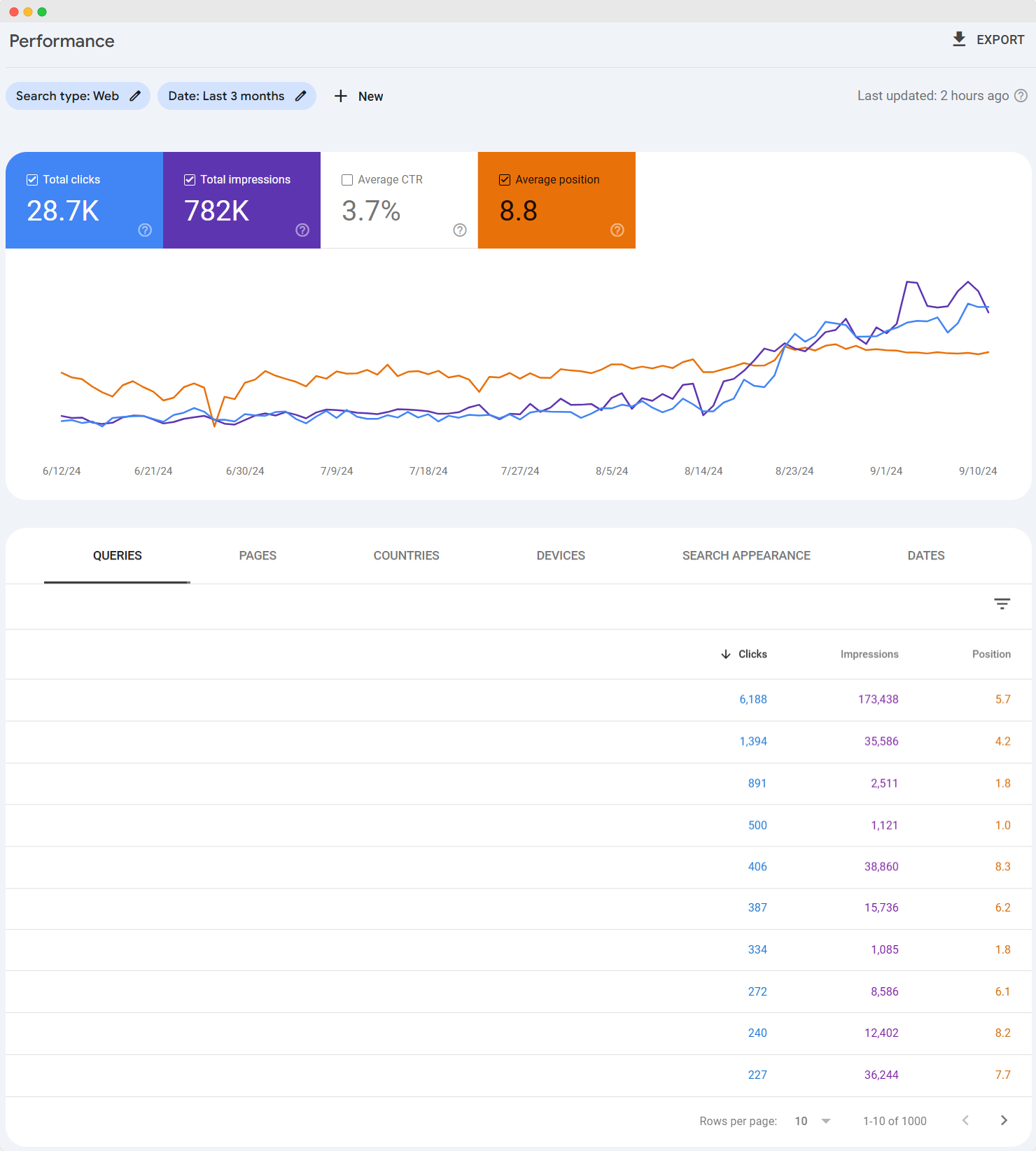Keyword research for SEO involves systematically identifying and analyzing search terms users input into search engines. This process begins with brainstorming “seed” keywords related to our business or topic.
Utilize keyword research tools to expand our list and gain insights into search volume, competition, and user intent. Analyze competitors’ keyword strategies to uncover gaps and opportunities.
Prioritize keywords based on their potential impact on traffic, conversions, and overall business goals. Consider search volume, keyword difficulty, and relevance when evaluating keywords.
TL;DR
Hide- Start by brainstorming seed keywords related to our business, products, or services.
- Analyze competitor keywords to identify gaps and opportunities in our strategy.
- Use keyword research tools to expand our list and gain insights into search trends.
- Study our niche to understand industry trends, user behavior, and emerging topics.
- Evaluate and prioritize keywords based on search volume, difficulty, relevance, and business potential.
Understanding parent topics and search intent is vital for aligning content with user expectations and improving rankings. Mastering these techniques will substantially enhance our SEO strategy.
Keyword Research Basics in SEO

Keyword research is the systematic process of identifying and analyzing search terms that users enter into search engines when looking for information, products, or services.
This fundamental SEO practice enables website owners to understand their target audience‘s search behavior and align their content with user intent.
What is keyword research?
At the foundation of any successful SEO strategy lies keyword research, a methodical process of identifying and analyzing the search terms that potential customers use to find products, services, or information online.
This essential component of SEO involves uncovering valuable insights into user behavior, market trends, and competitive landscapes.
A thorough keyword research guide emphasizes the importance of understanding how to search for keywords effectively, as it directly impacts a website’s visibility and organic traffic.
Keyword research in SEO encompasses several vital steps: identifying seed keywords, analyzing search volume and competition, evaluating user intent, and prioritizing keywords based on business objectives.
By utilizing specialized tools and techniques, marketers can uncover high-potential keywords that align with their target audience’s needs and search habits.
This data-driven approach enables businesses to optimize our SEO content strategy, improve search engine rankings, and attract qualified traffic.
Moreover, keyword research SEO extends beyond mere search term identification.
It provides invaluable insights into content gaps, emerging trends, and potential market opportunities, fostering innovation and strategic decision-making in digital marketing efforts.
Why keyword research matters?
In the domain of digital marketing, keyword research stands as a cornerstone of effective SEO strategies. Understanding why keyword research matters is vital for businesses aiming to optimize their online presence.
Keyword research for SEO provides invaluable insights into consumer behavior, market trends, and search patterns, enabling marketers to align their content with user intent and search engine algorithms.
How to do keyword research effectively involves analyzing search volumes, competition levels, and relevance to target audiences.
This process helps identify opportunities for ranking higher in search engine results pages (SERPs) and attracting qualified traffic.
Keyword research analysis reveals gaps in content strategies, allowing businesses to create targeted, high-value content that meets user needs.
Learning how to do SEO keyword research is essential for staying ahead in the digital landscape. It informs content creation, on-page optimization, and overall digital marketing strategies.
By understanding why keyword research matters, businesses can make data-driven decisions, allocate resources efficiently, and maximize their online visibility.
Ultimately, effective keyword research leads to improved organic search performance, increased website traffic, and higher conversion rates, driving sustainable growth in the competitive digital marketplace.
Finding Keyword Ideas
Finding keyword ideas is a critical step in the SEO process, involving multiple strategies to uncover valuable search terms.
The process typically begins with brainstorming “seed” keywords related to the business or topic, followed by analyzing competitors’ keyword rankings to identify potential opportunities.
Advanced keyword research tools, combined with a thorough understanding of the niche, can further expand the list of potential keywords and provide valuable insights into search trends and user intent.
1. Brainstorming “seed” keywords
How does one begin the keyword research process? The foundation of effective keyword research for SEO lies in brainstorming “seed” keywords.
These initial terms serve as the starting point for discovering a broader range of relevant search queries.
To generate seed keywords, consider our website’s core topics, products, or services. Analyze our target audience‘s language and pain points to identify how they might search for solutions.
Utilize industry jargon and common synonyms to expand our list.
When learning how to do keyword research for SEO, it’s vital to think like our potential customers. Consider variations in search intent, such as informational, navigational, or transactional queries.
To further refine our approach on how to search keywords, leverage tools like Google’s “People Also Ask” feature or autocomplete suggestions.
These provide insights into related terms and questions users frequently search for. Additionally, examine our website’s analytics data to identify existing keywords driving traffic.
2. Checking competitor keywords
Analyzing competitor keywords provides valuable insights for expanding our own keyword strategy.
By examining the search terms that drive traffic to our competitors’ websites, you can identify untapped opportunities and refine our SEO approach.
Start by compiling a list of our top competitors in the industry, then utilize advanced SEO tools to uncover their most valuable keywords.
Tools like Ahrefs, SEMrush, and Moz offer competitive analysis features that reveal organic and paid keywords for any domain.
These platforms provide data on search volume, keyword difficulty, and ranking positions, allowing you to prioritize high-potential keywords.
Focus on identifying gaps in our current strategy by looking for keywords our competitors rank for that you don’t.
Additionally, analyze our competitors’ content structure and on-page optimization techniques. This can provide insights into effective content formats and keyword placement strategies.
Pay attention to long-tail keywords and question-based queries that our competitors target, as these often have lower competition and higher conversion potential.
3. Using keyword research tools
Keyword research tools offer powerful capabilities for identifying matching and related terms to expand our keyword list.
These tools analyze vast amounts of search data to suggest variations of our seed keywords, including synonyms, long-tail phrases, and semantically related concepts.
Matching terms
Among the various features offered by keyword research tools, matching terms functionality stands out as a powerful method for expanding our keyword list.
This feature identifies semantically related keywords, synonyms, and variations of our seed keywords.
By utilizing machine learning algorithms and vast databases, these tools uncover niche-specific terms and long-tail keywords that may have been overlooked.
This innovative approach enables SEO professionals to discover high-potential keywords with lower competition, enhancing content strategies and improving search visibility.
Related terms
Exploring related terms is a vital component of exhaustive keyword research when using specialized tools.
These tools leverage vast databases and algorithms to suggest semantically connected keywords, expanding our targeting options.
They provide:
- Semantic variations and synonyms
- Long-tail keyword phrases
- Topically related terms
This data-driven approach uncovers opportunities beyond initial seed keywords, enabling innovative content strategies.
4. Studying the Niche
To effectively uncover valuable keyword opportunities, studying the niche is an essential first step in the keyword research process.
This involves a thorough analysis of the industry landscape, competitor strategies, and target audience behavior.
By immersing oneself in the niche, SEO professionals can identify emerging trends, pain points, and unique selling propositions that can inform keyword selection.
| Research Method | Purpose | Outcome |
|---|---|---|
| Competitor Analysis | Identify gaps and opportunities | Uncover high-potential keywords |
| Industry Forums | Gauge user discussions | Discover long-tail keyword ideas |
| Social Media Monitoring | Track trending topics | Identify timely and relevant keywords |
Utilizing advanced tools and techniques, such as natural language processing algorithms and semantic analysis, can provide deeper insights into the niche’s linguistic patterns and search behavior.
This data-driven approach enables the identification of niche-specific jargon, industry acronyms, and specialized terminology that may not be apparent through traditional keyword research methods.
Analyzing Keywords
Analyzing keywords involves evaluating several key metrics to determine their potential value for SEO efforts.
Search volume indicates the number of monthly searches for a keyword, while traffic potential estimates the overall search demand for a topic.
Keyword difficulty assesses the level of competition for ranking, and Cost Per Click (CPC) provides insight into the keyword’s commercial value in paid advertising campaigns.
Search Volume
In keyword research, search volume stands as a vital metric for evaluating the potential traffic a keyword can generate.
This metric represents the average number of monthly searches for a specific keyword across search engines.
Higher search volumes typically indicate greater popularity and potential visibility for a website targeting those keywords.
When analyzing search volume, SEO professionals consider several factors:
- Seasonality: Some keywords may have fluctuating search volumes throughout the year
- Geographic variations: Search volumes can differ notably across regions or countries
- Long-term trends: Historical data can reveal whether a keyword’s popularity is increasing or declining
It’s essential to balance search volume with other metrics like keyword difficulty and relevance to our business.
While high-volume keywords may seem attractive, they often face intense competition, making it challenging for new or smaller websites to rank well.
Conversely, low-volume keywords might offer easier ranking opportunities but may not drive sufficient traffic.
Advanced SEO strategies often involve targeting a mix of high and low-volume keywords, creating a thorough keyword portfolio.
This approach allows websites to capture traffic from both competitive and niche searches, maximizing overall visibility and potential conversions.
Traffic Potential
Traffic potential, a critical factor in keyword analysis, goes beyond mere search volume to provide a more in-depth view of a keyword’s value.
While search volume indicates the number of queries for a specific keyword, traffic potential estimates the total organic traffic a page could receive if it ranks in the top position for that keyword.
To accurately assess traffic potential, consider the following factors:
| Factor | Description | Impact |
|---|---|---|
| SERP Features | Presence of ads, featured snippets, etc. | Can reduce organic click-through rates |
| Keyword Intent | Informational, navigational, or transactional | Influences user behavior and conversion rates |
| Topic Relevance | How well the keyword aligns with our content | Affects ranking potential and user engagement |
| Competitor Analysis | Existing top-ranking pages’ performance | Provides insights into achievable traffic levels |
Keyword difficulty
Keyword difficulty is an essential metric in SEO that measures the level of competition for a specific search term.
It indicates how challenging it would be for a website to rank on the first page of search engine results for a particular keyword.
SEO professionals use this metric to assess the feasibility of targeting certain keywords and to prioritize their optimization efforts.
When analyzing keyword difficulty, consider the following factors:
- Domain authority of top-ranking websites
- Quality and relevance of content on competing pages
- Number and quality of backlinks to ranking pages
Tools like Ahrefs, SEMrush, and Moz provide keyword difficulty scores, typically on a scale of 0-100, with higher scores indicating greater competition.
These scores are based on complex algorithms that evaluate various ranking factors. However, it’s imperative to remember that keyword difficulty is not an absolute measure.
A website’s ability to rank for a keyword depends on its own authority, content quality, and overall SEO strategy.
By balancing keyword difficulty with other metrics like search volume and relevance, SEO practitioners can identify opportunities to target less competitive keywords while still driving meaningful traffic to their websites.
Cost Per Click (CPC)
Cost Per Click (CPC) analysis plays a crucial role in evaluating the commercial value of keywords for SEO and paid advertising strategies. CPC represents the average amount advertisers pay for each click on their ads when targeting specific keywords.
This metric provides insights into the potential revenue generation and competitiveness of keywords in the paid search landscape.
Higher CPC values often indicate greater commercial intent and competition for keywords, suggesting potential profitability for organic SEO efforts.
By analyzing CPC data, SEO professionals can identify high-value keywords that may yield substantial returns on investment when targeted through organic search optimization.
To leverage CPC data effectively, marketers should:
- Prioritize keywords with higher CPCs for content creation and optimization
- Identify niche opportunities with moderate CPCs and lower competition
- Use CPC trends to anticipate shifts in market demand and adjust strategies accordingly
- Correlate CPC data with search volume and difficulty metrics for a thorough keyword evaluation
Integrating CPC analysis into the keyword research process enables data-driven decision-making, allowing businesses to allocate resources efficiently and maximize the potential return on their SEO investments.
This approach fosters innovation in content strategy and helps maintain a competitive edge in the ever-evolving digital landscape.
Targeting SEO Keywords
Identifying the parent topic of a keyword helps establish a broader content strategy and enables effective keyword grouping.
Understanding search intent is vital for aligning content with user expectations and improving search engine rankings.
These two factors, when combined, allow for more targeted and efficient SEO keyword implementation, ultimately enhancing a website’s visibility and relevance in search results.
1. Identifying the Parent Topic
A critical aspect of targeting SEO keywords involves identifying the parent topic, which serves as the overarching theme for a group of related keywords.
This process helps establish a hierarchical structure for content, ensuring exhaustive coverage of a subject while optimizing for search engines.
By recognizing parent topics, SEO professionals can develop content clusters that address various aspects of a broader theme, enhancing topical authority and improving search visibility.
To effectively identify parent topics:
- Analyze search intent patterns across related keywords
- Utilize topic modeling tools to uncover thematic relationships
- Examine Google’s “People Also Ask” and related searches for topic connections
Parent topics often represent high-level concepts that encompass multiple subtopics and long-tail keywords. By focusing on these broader themes, websites can create pillar content that serves as a foundation for more specific, related articles.
This approach not only improves internal linking structure but also signals to search engines the depth and breadth of expertise on a particular subject.
Ultimately, identifying parent topics enables a more strategic approach to content creation, aligning with both user needs and search engine algorithms to maximize organic visibility and traffic potential.
2. Understanding search intent
Search intent’s significance in targeting SEO keywords cannot be overstated. It refers to the underlying purpose behind a user’s search query and plays a vital role in determining the type of content that will satisfy their needs.
By accurately identifying and aligning with search intent, websites can improve their chances of ranking higher in search engine results pages (SERPs) and attracting qualified traffic.
There are four primary types of search intent: informational, navigational, commercial, and transactional.
Informational queries seek knowledge or answers, while navigational searches aim to find specific websites or pages.
Commercial intent involves researching products or services before making a purchase, and transactional searches indicate a readiness to buy or take action.
To effectively target SEO keywords, key analysis of the current SERP results for each keyword is vital.
Identifying patterns in content format, structure, and depth helps determine the dominant search intent and informs content creation strategies.
Prioritizing Keywords
Evaluating the business potential of keywords is a critical step in the prioritization process.
This evaluation involves analyzing factors such as search volume, competition, and relevance to the company’s products or services.
Once the business potential is assessed, keywords can be prioritized based on their potential impact on traffic, conversions, and overall business goals, allowing SEO efforts to focus on the most valuable targets first.
Evaluating the Business Potential of a Keyword
When prioritizing keywords for SEO, evaluating their business potential is a critical step that goes beyond mere search metrics.
This process involves evaluating how well a keyword aligns with our business objectives and its likelihood of driving conversions.
To determine a keyword’s business potential, analyze its relevance to our products or services, the user intent behind the search, and its potential to attract high-value customers.
Consider the following factors when evaluating business potential:
- Conversion intent: Keywords with commercial or transactional intent often have higher business value
- Customer lifetime value: Prioritize keywords that attract customers with long-term revenue potential
- Alignment with business goals: Focus on keywords that support our overall strategic objectives
Utilize data-driven approaches to quantify business potential, such as assigning monetary values to different keyword types based on historical conversion data.
Implement machine learning algorithms to predict the potential return on investment for specific keywords, considering factors like seasonality and market trends.
Prioritizing Which keywords to Focus on First
After conducting thorough keyword research, the next critical step is prioritizing which keywords to focus on first.
This process involves analyzing multiple factors to determine which keywords offer the highest potential return on investment for SEO efforts.
Key metrics to evaluate include search volume, keyword difficulty, and business relevance. High search volume indicates significant user interest, while lower keyword difficulty suggests easier ranking opportunities.
Business relevance guarantees alignment with organizational goals and target audience needs.
Utilize a data-driven approach by creating a scoring system that weights these factors based on their importance to our specific situation.
Implement a matrix that plots keywords according to their potential impact and effort required, focusing on those in the high-impact, low-effort quadrant.
Evaluate the search intent behind each keyword, prioritizing those that align with our content capabilities and conversion funnel stages.
Analyze competitor rankings to identify gaps and opportunities in the market.
Leverage advanced tools to forecast potential traffic and revenue for each keyword, allowing for more precise prioritization.
Continuously iterate and refine our prioritization strategy as you gather performance data and market conditions evolve.
Using Google Search Console for SEO Keyword Research

Google Search Console is a valuable asset for refining your website’s search engine optimization (SEO) through informed keyword research.
The platform provides detailed insights into the search queries that drive users to your site, including metrics such as impressions, clicks, and click-through rates (CTR).
This information enables you to identify high-performing keywords and areas for improvement.
Analyzing search terms with high impressions but low CTR facilitates the identification of content gaps, allowing you to create more targeted and relevant content that attracts additional clicks.
For instance, if a specific keyword generates many impressions but few clicks, refining your page titles and meta descriptions to be more engaging can potentially enhance CTR.
The Search Console offers a range of reports, including the Queries Report and the Pages Report.
The Queries Report provides an overview of the search terms users employ to find your site, including long-tail keywords and specific questions within your niche.
This data is instrumental in expanding your keyword list and tailoring your content to user interests.
The Pages Report highlights the performance of individual pages in search results. Analyzing pages with high impressions but low engagement enables you to identify content that may require updating or improved keyword optimization.
Search Console Insights, a beta feature, offers a broad perspective on how users discover and interact with your content.
It identifies the content that drives the most traffic and engagement, allowing you to identify gaps in your content strategy.
This information guides the creation of new material that resonates with your audience and targets valuable keywords.
Additionally, Google Search Console provides data on your site’s internal linking structure and external links pointing to your site.
Understanding which pages have few or no internal links – often referred to as “orphaned” pages – can facilitate improvements to site navigation and make important content more accessible to users and search engines.
Transforming data from Search Console into actionable SEO strategies enhances your keyword research efforts. Creating content clusters around high-impression keywords with low CTR addresses content gaps and improves your site’s relevance for those search terms.
Google Search Console offers these benefits at no cost, providing unlimited access to data and reports. It is an essential resource for website owners seeking to make data-driven decisions in their keyword research and SEO optimization.
Analyzing historical data in Search Console can reveal seasonal trends and timely topics, enabling you to plan content creation around periods of increased interest.
By staying informed about these trends, you can produce content that attracts more traffic during peak times.
Examining user queries enables you to refine your content to address specific questions and long-tail keywords in your niche. This approach improves your site’s relevance and authority, leading to improved search rankings and increased traffic.
Overall, Google Search Console is a strategic asset for refining your website’s performance through informed keyword research.
By thoroughly analyzing the data it provides and implementing informed SEO actions, you can enhance visibility, attract more visitors, and achieve your online objectives.
I have covered the comprehensive guide on how to find content ideas with Google Search Console, you might want to read if in details to learn how to do keyword research for SEO using Google Search Console, as well as finding content ideas for better content strategies..
Final Thoughts
Effective keyword research is vital for SEO success. By systematically identifying, analyzing, and prioritizing relevant search terms, businesses can optimize their content strategy and improve organic visibility.
The process involves brainstorming seed keywords, leveraging research tools, evaluating metrics, and analyzing competitor strategies.
A data-driven approach to keyword selection, considering factors like search volume, difficulty, and business potential, enables organizations to target high-value terms aligned with user intent.
Continuous refinement of keyword strategies is essential to adapt to evolving search trends and maintain competitive advantage.



